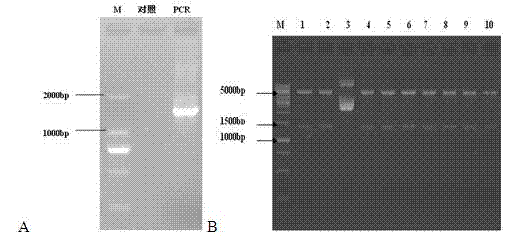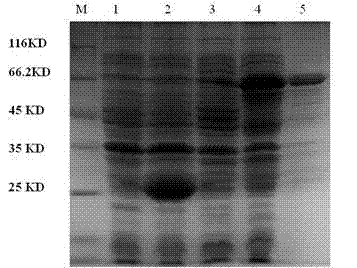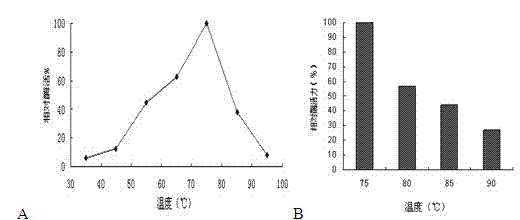Recombinant strain capable of expressing thermostable Beta-galactosidase and construction method and application
A technology of galactosidase and recombinant bacteria, which is applied in the field of applied microorganisms, can solve the problems of poor thermal stability and low reaction temperature, and achieve the effects of wide reaction range, strong tolerance and good enzyme activity
- Summary
- Abstract
- Description
- Claims
- Application Information
AI Technical Summary
Problems solved by technology
Method used
Image
Examples
Embodiment 1
[0023] Extraction of total DNA of flora and cloning of thermostable β-galactosidase gene:
[0024] Use the improved CTAB / NaCl method to extract the bacterial flora YTY-70 enriched from Yongtai Hot Spring (use a deep water sampler to take a deep water sample at 2-3 meters from the hot spring at 70°C, and store the sample in an anaerobic bottle immediately. Refrigerated treatment. Use the Hugate anaerobic culture method to add 1% inoculum to 100 mL enrichment medium, change to the screening medium after one week, and transfer for 15 generations to enrich the relevant cellulose-using flora , to obtain the total DNA of the flora YTY-70), using the following degenerate primers: GlaF: 5'-ATG AGT TTT(A,C) CCA AAA GGA TT-3', GlaR: 5'-TTA C(T)GA G(A)TT TTC CTT TAT AT-3' amplifies the gene for the thermostable β-galactosidase enzyme. The PCR reaction system was as follows: 5 min at 95°C; 30 more cycles: 1 min at 95°C; 1 min at 57°C, 2 min at 72°C; and a final extension at 72°C for 10 m...
Embodiment 2
[0026] Construction of heat-resistant β-galactosidase recombinant engineering bacteria:
[0027] The expression vector pGEX-4T-2 was used Bam HI and xho I was subjected to double enzyme digestion, and digested at 37°C for 3h. Large fragments were recovered from agarose gels. The target fragment amplified with embodiment 1 is also used Bam HI and xho I carry out double enzyme digestion, and agarose gel recovers the target gene fragment. Link the recovered gene fragment of β-galactosidase to the expression vector PGEX-4T-2, transform it into Escherichia coli competent cells, spread it on the LB plate containing Amp100ug / ml, and pick 10 positive recombinants Clones were put into fresh LB medium containing Amp100ug / ml and plasmids were extracted. Then double enzyme digestion and sequencing were used to identify whether the target gene was successfully inserted. The cloned plasmids successfully inserted into the target fragments were sent out for sequencing again.
[...
Embodiment 3
[0030] Expression and purification of recombinant thermostable β-galactosidase:
[0031] (1) Pick a single colony containing the recombinant plasmid (containing the heat-resistant β-galactosidase gene), inoculate it in 2×YT medium, and culture it overnight at 37°C and 250 rpm. Transfer the overnight bacteria to 100 mL of fresh 2×YT liquid medium containing 100 mg / mL Amp according to 1% inoculum, cultivate to OD at 37°C, 250 rpm 600is 0.8. Add IPTG to a final concentration of 1 mmol / L, shake and culture at 37°C for 4-6 h to induce expression of the recombinant protein.
[0032] (2) Centrifuge the culture solution at 10,000 rpm for 5 minutes at 4°C, discard the supernatant, collect the cells, and place them on ice. Collect the cells that induce expression.
[0033] (3) Add ice-cold 10 ml PBS buffer per mL of culture. Bacteria were lysed by ultrasonic in an ice bath, ultrasonic condition: 150W, working for 10 s, interval of 10 s, 30 times.
[0034] ⑷ Add 20% Triton X-100 to ...
PUM
 Login to View More
Login to View More Abstract
Description
Claims
Application Information
 Login to View More
Login to View More - R&D
- Intellectual Property
- Life Sciences
- Materials
- Tech Scout
- Unparalleled Data Quality
- Higher Quality Content
- 60% Fewer Hallucinations
Browse by: Latest US Patents, China's latest patents, Technical Efficacy Thesaurus, Application Domain, Technology Topic, Popular Technical Reports.
© 2025 PatSnap. All rights reserved.Legal|Privacy policy|Modern Slavery Act Transparency Statement|Sitemap|About US| Contact US: help@patsnap.com



